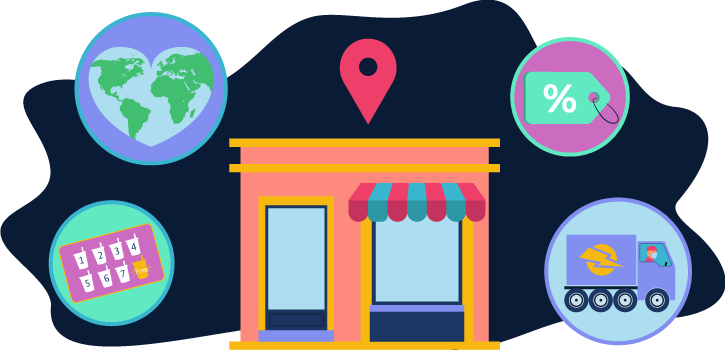Online shopping has been a huge industry ever since the introduction of the internet, however due to the Covid-19 pandemic, the demand for online stores has increased dramatically. Demographics who traditionally would opt to shop in retail stores, had no choice but to shop online.
It has been estimated that global eCommerce sales will count for over 22% of all transactions by 2023. When done right, online shopping establishes a 24/7 connection to a far larger audience than any brick-and-mortar store, while simultaneously delivering an immersive and convenient shopping experience that ultimately translates to increased conversions.
Due to the recent changes in the way people go about their daily activities, the online retail industry has become even more competitive. Businesses who want to succeed in this dynamic and ever-changing arena, must keep pace with consumer demands.
Appreciating the current and emerging eCommerce trends can help businesses stay ahead of the competition. Focus on the following areas, and you won’t go far wrong.
Social commerce
It is impossible to think about digital marketing in 2021 without considering social media. Likewise, trying to master the world of online shopping without the presence of social commerce would be business suicide.
Over half of the world’s population is now signed up to at least one social media platform, and they regularly interact with companies by following their pages or accounts. Thanks to the plethora of insights available, those touchpoints are about more than brand awareness alone. They can actively guide consumers along the path to conversion. Thanks to social commerce, users are able to shop directly through those pages.
Facebook, Twitter, Instagram, et al. have long used adverts and content that can redirect interested users to specific product pages.
However, Instagram has evolved its shopping platform to now incorporate the Instagram checkout feature that allows users to purchase products directly from the app. When a user clicks on the linked product, they are taken to a product description page and checkout from within the brand’s Instagram page. It’s fast, convenient, and gives companies a chance to keep up with the trend with ease.
Social commerce works for many different reasons. Consumers are relaxed when browsing social media feeds while the combination of visual content and the power of recommendation can influence their decisions.
If you are serious about tapping into the online retail market, social commerce is key. This industry is estimated, as per Researchandmarkets.com, to surpass $600bn by 2027. With consumers now spending more time than ever interacting with brands in this manner, now is the time to invest heavily in this aspect of the digital strategy.
AI
Artificial Intelligence is hardly a new concept of business and has been adopted in many aspects of manufacturing and operational management. However, its impact on the consumer journey has been somewhat limited. That is about to change and its widespread utilisation will make it the most noticeable eCommerce trends of the next 12 months.
Now is the perfect time for small businesses to adopt AI in relation to the consumer experience. Aside from the fact that Covid has led to a lack of human interactions, Gartner reports that 64% of consumers care more about the experience than the price of a product (within reason) and will happily pay a little more for a good UX.
Data analytics and insights can predict behavioral trends among your demographic and visitors. This can help automate (or at least guide) marketing campaigns and consumer interactions. Whether it’s using Automat to learn from customer behaviors or using a client’s previous orders, or using data collection software to gather more customer information, it can help create a more personalized shopping experience. In turn, consumers will feel more valued, which is likely to result in improved customer retention.
Other AI tools include chatbots, which are the #1 fastest growing brand communication. A growing number of consumers, especially from younger generations, actively prefer to speak to them. They regularly cite the speed of resolutions and the fact that it avoids any anxiety as the key reasons for this.
AI sounds daunting due to the advanced nature of the technologies used. However, most tools are now affordable and have user-friendly interfaces that encourage easy integrations. So, it’s no longer limited to big brands and is one of the most universal eCommerce trends of this era.
Environmental sustainability
Adopting greener processes has become an increasingly conscious part of modern commerce, particularly when dealing with eCommerce. Therefore, in 2021 it will be more important than ever for online retailers to focus on the eCommerce trends of thinking green.
Reducing your carbon footprint can cut expenses, deliver a sense of added satisfaction, and impress your employees. In the modern climate, showing your social responsibility is also an immensely powerful marketing tool.
In fact, as per the Harvard Business Review, 65% of buyers actively want to align themselves with brands that actively conduct their business in an environmentally sustainable manner.
Environmental sustainability can be shown in many ways. Global giants are leading the way, with Microsoft pledging to be carbon negative by 2030. Meanwhile, Amazon has a similar pledge to reach that target by 2040. Your business may not be in a position to outperform those organizations, but there are still plenty of seats at the eco-friendly table.
For SMEs working in the eCommerce arena, environmental sustainability should focus on a combination of consumer-facing and behind-the-scenes moves. Developments within the global renewables industries have resulted in more affordable solar and wind power than ever before. While the switch to greener energy isn’t something that consumers see on a daily basis, you can still make it known by celebrating milestones through social media and press releases.
Eco-friendly packaging is a more noticeable change that consumers will respond to. Plastics are the biggest danger to our oceans and environment. Switching to recyclable packaging that avoids the use of BPA plastics should be high on the agenda, especially as modern design and printing techniques allow you to rejuvenate the brand.
Other top tips for environmental sustainability include avoiding unnecessary travel, changing on-site habits, adopting paperless tech, and aligning yourself with likeminded suppliers. When done well, it will also help facilitate growth and expansion. For that reason, combined with the consumer expectations and demands, it is a trend you must not ignore in the months to come.
When recapping the latest eCommerce trends for the second half of 2021, it’s clear that branding and developing stronger customer relationships are the keys to success. By understanding the mindset of a modern consumer, you can tailor your marketing plans to match the latest eCommerce trends.
In turn, it should bring an increase in traffic, conversions, and long-term loyalty.
________________________________________________________________________
Rebecca DiCioccio is the marketing manager at Paperform. Outside of work, Rebecca can be found exploring the outdoors, or with a book in hand. Rebecca’s background in copywriting and keen interest in SEO and digital marketing mean she understands the importance of staying up to date with the latest trends in a dynamic and ever changing industry.







